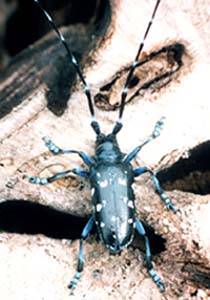Asian Longhorned Beetle Pest Profile


Description
Adults are 20-35 mm in length and 7-12 mm in width. Their color is jet-black with a luster. The antennae have 11 segments. The base of the antennae are whitish with a blue-black color. The antennae of the males are 2.5 times their body length; the antennae of the females are 1.3 times their body length. The base of the eyltra does not have a granular structure. Each eyltron has about 20 white dots.
History
Asian Longhorned Beetle thus far has been attacking maple, horsechestnut, poplar, and other trees in the urban and suburban area of New York and Long Island. Timber, nursery stock, shade tree and maple syrup production are all at risk. According to the Empire State Forest Products Association, these industries employ more than 60,000 people. As an invasive, the beetle is expected to encounter few natural enemies. This factor will influence a rapid expansion of populations by natural means.
Distribution
Asian Longhorn Beetle is a native insect of Northeast Asia. It is found throughout China except Xingjaiang, Tebit, Qinghai, Hainan and Taiwan. It is also recorded in Korea and Japan. ALB has just recently been found in Amityville and Brooklyn, New York.
Life Cycle
A typical life cycle for this pest is:
Egg Stage: The off-white, oblong eggs are 5-7 mm in length. Both ends of the eggs are slightly concave.Larva: Mature larvae are 50 mm in length. The prothorax has a brown mark. The front of the mark does not have a brown margin.Pupa: The off-white pupae are 30-33 mm in length, width of 11 mm. The eighth segment of the abdomen has a protruding structure.Adult Stage: Adults are 20-35 mm in length and 7-12 mm in width. Their color is jet-black with a luster.
Host and Damage
Asian Longhorn Beetle alters the appearance of hardwood trees, especially maple and horsechestnut. Infested trees become unsightly, drop dead branches, and eventually die.
History and Economic Importance
Asian Longhorned Beetle thus far has been attacking maple, horsechestnut, poplar, and other trees in the urban and suburban area of New York and Long Island. Timber, nursery stock, shade tree and maple syrup production are all at risk. According to the Empire State Forest Products Association, these industries employ more than 60,000 people. As an invasive, the beetle is expected to encounter few natural enemies. This factor will influence a rapid expansion of populations by natural means.
